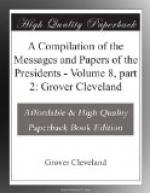Again, if this Mars Hill (and we confess we can not speak of the pretension with any patience) is the northwest angle, and the north boundary of Nova Scotia and the south boundary of the Province of Quebec are the same, and north of the Bay de Chaleurs, then there is indeed no northwest angle, for a line due north from the monument, passing by Mars Hill, must pursue nearly the same direction to get to the north of that bay without crossing it; and who ever thought of an angle at the side of a continuous line? Now, according to the British maps taken in this very case, you must run a course of north about 14 deg. east to obtain the north side of the bay without crossing it, and the distance would be in this almost due north direction more than 100 miles, while that from the monument to Mars Hill would be little more than 40. Now when we consider that this northerly line must form nearly a right angle to pass along the north shore of the Bay de Chaleurs, that this is 100 miles farther north than Mars Hill, where instead of an angle there can be only an inclination of 14 deg., can there be a greater absurdity than the British claim founded on these facts?
We will now present some facts and remarks in regard to the surveys and explorings made by the commission under the fifth article of the treaty of Ghent, and the first fact that occurs is that the elevations taken by the British surveyor stop far short of where the waters divide, and we find no proof that these elevations were carried through by our own surveyors. If the British surveyor, after ascertaining he was still ascending and had in fact arrived at the lands at a branch of a river elevated 500 feet above the summit of Mars Hill, found it prudent to stop short, we see no good reason why the American agent did not proceed on and take accurate elevations at a place where the waters divide. If such a survey was made, the committee have not been able to obtain the evidence. It is not in the maps or documents in the library or office of the Secretary of State, and the committee believe that no such elevations have been taken northerly of the first waters of the Restigouche. It is, indeed, a little singular that we have so little evidence, not only in regard to this height of land, but also of the rivers which flow into the St. Lawrence to the left, and especially to the right, of the north line from the monument.
We know some of them, to be sure, such as the Oelle Kamouska, Verte, Trois Pistoles, Remouskey, and Metis on the left, and the Blanche, Louis, Magdalen, and others on the right of this line, but we know them chiefly as on maps and as transcribed from older maps, but very little from actual survey or even exploration. An examination of the sources of those rivers at the right of this north line, with the important natural boundary, the north shore of the Bay de Chaleurs, would accurately define the divisional line between the Province of Quebec and Nova Scotia, which extending west would intersect the due north line and thus form the northwest angle of Nova Scotia.




